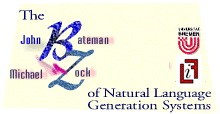
| System Name |
SumTime
|
 |
| System Builders | Reiter, Sripada, Yu, Hunter
|
|
| Development Dates | 2001-ongoing | |
| Languages | English | |
| URL (if available) | http://www.csd.abdn.ac.uk/research/sumtime | |
|
Our goal is to develop technology for producing English summary descriptions of a time-series data set. Currently there are many visualisation tools for time-series data, but techniques for producing textual descriptions of time-series data are much less developed. ... From a natural-language generation perspective, we expect to focus on lexicalisation and user-modelling. For example, we need to write rules which determine when a particular data set can be described as ""rising""; prototype or exemplar models of word meaning may be useful here. We also need to define user models which allow us to decide what information should be communicated in a space-limited text, given the huge number of things that could be said about a particular data set. This should be a very exciting project for anyone interested in the challenge of generating good English texts from non-linguistic input data. To take a concrete example, consider the following extract from a (real-life) weather report: Saturday will be yet another generally dull day with early morning mist or fog and mainly cloudy skies being prevalent. There will be the odd bright spell here and there, but it will feel rather damp with patches of mainly light rain to be found across many parts, especially the west and south.This was produced by a human forecaster from an underlying data set (generated by numerical modelling and prediction techniques) which gave predictions for meteorological parameters such as precipitation, temperature, wind speed, and cloud cover at various altitudes, at regular intervals for various points in the area of interest. The underlined phrases are some of the places where the human forecaster has used short textual summaries to describe this complex data. Our goal is to be able to perform similar types of summarisation in a computer system. That is, for example, to take raw data on cloud cover and solar flux over course of a day, and from this produce a phrase such as odd bright spell here and there. This involves research in both time-series analysis (to detect patterns and phenomena in the data) and natural-language generation (to decide how to best describe these patterns and phenomena in language). |
Ehud Reiter.
An architecture for data-to-text systems.
In Stephan Busemann, editor, Proceedings of the 11th European Workshop on Natural Language Generation, pages 97--104, 2007.link
Ehud Reiter and Somayajulu Sripada. Ehud Reiter and Somayajulu G. Sripada. Ehud Reiter and Somayajulu G. Sripada. Somayajulu G. Sripada, Ehud Reiter, Jim Hunter, Jin Yu, and Ian P. Davy. Somayajulu G. Sripada, Ehud Reiter, Jim Hunter, and Jin Yu. Somayajulu G. Sripada, Ehud Reiter, Jim Hunter, and Jin Yu. Somayajulu G. Sripada, Ehud Reiter, Jim Hunter, and Jin Yu. Sripada Somayajulu, Ehud Reiter, Jim Hunter, and Jin Yu. Jin Yu, Jim Hunter, Ehud Reiter, and Somayajulu Sripada. Jin Yu, Jim Hunter, Ehud Reiter, and Somayajulu Sripada.
Information last updated: 12.10.2002 (dd.mm.yy)
Contextual influences on near-synonym choice.
In Anja Belz, Roger Evans, and Paul Piwek, editors, Natural Language Generation: Third international Conference (INLG 2004), number 3123 in Lecture Notes in Artificial Intelligence, pages 161--170. Springer, Berlin, New York, July 14-16 2004.
Human Variation and Lexical Choice.
Computational Linguistics, forthcoming.linkhttp://www.csd.abdn.ac.uk/~ssripada/sumtime/cl02.pdf
Should Corpora Texts be Gold Standards for NLG?
In Proceedings of the International Natural Language Generation Conference 2002 (INLG2002), pages 97--104, 2002.link

Modelling the Task of Summarising Time Series Data using KA Techniques.
In Applications and Innovations in Intelligent Systems IX: Proceedings of the International Conference on Knowledge Based Systems and Applied Artifical Intelligence (ES2001), pages 183--196, Cambridge, 2001. The British Computer Society SGAI: The Specialist Group on Artificial Intelligence.link
SumTime: Observations from KA for Weather Domain.
Technical Report AUCS/TR0102, Computing Science Department, University of Aberdeen, 2001.link
SUMTIME-METEO: Parallel Corpus of Naturally Occurring Forecast Texts and Weather Data.
Technical Report AUCS/TR0201, Computing Science Department, University of Aberdeen, 2002.link
Segmenting Time Series for Weather Forecasting.
In Proceedings of The Twenty-second SGAI International Conference on Knowledge Based Systems and Applied Artificial Intelligence (ES2002), Cambridge, U.K., December 2002. The British Computer Society SGAI: The Specialist Group on Artificial Intelligence.link
A Two-Stage Model for Content Determination.
In Proceedings of ENLGW-2001, pages 3--10, 2001.
An approach to generating summaries of time series data in the gas turbine domain.
In Proceedings of IEEE International Conference on Info-tech \& Info-net (ICII2001), pages 44--51, Beijing, 2001.link
Recognising Visual Patterns to Communicate Gas Turbine Time-Series Data.
In Proceedings of The Twenty-second SGAI International Conference on Knowledge Based Systems and Applied Artificial Intelligence (ES2002), Cambridge, U.K., December 2002. The British Computer Society SGAI: The Specialist Group on Artificial Intelligence.link%
Page last generated: 25-1-2009 21:01:38